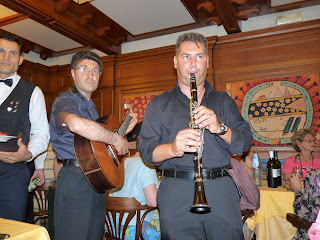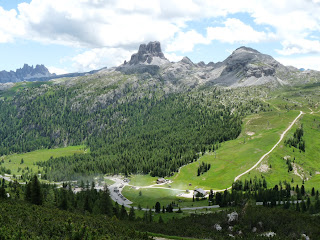There’s some advantage in being on a group tour - mainly, that you enter major attractions by the group tours entrance. Some of the line-ups we saw were over one hour long. Temperature was 32C.
St. Peter’s square, Basilica, Vatican Museum and Sistine Chapel all contain amazing art. Each of us wore a little radio receiver around our neck with an earpiece plugged in and listened to our guide, a local specialist, explain the details. Knowing something of the history of the church and what is preached compared to what is practiced by those who preach, and seeing the incomprehensible level of opulent luxury lived by the top administration of the outfit, I found myself as perplexed as ever with the state of human nature.Giant pine cone - symbol of Roman hospitality
Square (piazza) inside the Vatican Museum
Sculpture gallery contains art 'acquired' from all over the world
Fig leaves were added during certain regimes.
One of several ornate ceilings in the Vatican Museum
The gold standard of Pietas. Michaelangelo's consumate masterpiece.
Different marbles from near and far.
Entering St. Peter's Basilica
"Spare no expense!"
Dome of St. Peter's Basilica
Letters on band of pure gold leaf are 7 feet high. Click to see people above.
There were thousands of paintings too, but photos not allowed except for mosaics.
Holy water font at one entrance
Vatican Guard is still a career option for a young Swiss.
Impossible for us to capture the size of St. Peter's square.
This giant poster commemorating the beatification of my favourite Pole, is about 5 stories high.
In the late afternoon, Susan, Louise and I took the subway (Metro) downtown, then a cab, back to the violin shop only to find that the two instruments made by Claude Lebet had gone home with some one who wanted to buy them. As a consolation prize, the good maestro offered Susan an Italian 1765 violin and me a viola made in 1863 in the north of Italy. They don’t normally rent antique instruments so we were very happy with the arrangement. Susan actually liked the Lebet violin which she had tried yesterday more, but for me, this older viola, being a bit smaller in body size, was a better fit. As he listed them at 30,000 Euros each on the contract for insurance purposes, we very gingerly walked out on to the cobbled streets and decided to taxi home rather than jostle with gypsies on the Metro.
But first, we took a nice walk along the Tiber river. It has wide (20 feet) walkways on both sides and a few people were walking or biking along while restaurants and vendors of all sorts were completing their set-up for the evening’s business. We had a nice drink and light dinner at a table by the water. Very exclusive, four staff and we were the only customers because it was so early - 7:30 p.m. Most Romans work 9:00 or 10:00 until 1 or 2, then shutdown for 1 to 3 hours and return to work until about 7:00 p.m. Then they go and get ready to go out for the evening. Doesn’t seem to leave much time for bike riding or birding. Due to lack of green space and bike lanes, my guess is that Rome is one of the least likely cities in Europe to encounter a biker or birder.
Tomorrow, off to Pisa and Florence.
But first, we took a nice walk along the Tiber river. It has wide (20 feet) walkways on both sides and a few people were walking or biking along while restaurants and vendors of all sorts were completing their set-up for the evening’s business. We had a nice drink and light dinner at a table by the water. Very exclusive, four staff and we were the only customers because it was so early - 7:30 p.m. Most Romans work 9:00 or 10:00 until 1 or 2, then shutdown for 1 to 3 hours and return to work until about 7:00 p.m. Then they go and get ready to go out for the evening. Doesn’t seem to leave much time for bike riding or birding. Due to lack of green space and bike lanes, my guess is that Rome is one of the least likely cities in Europe to encounter a biker or birder.
Tomorrow, off to Pisa and Florence.



























































